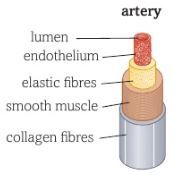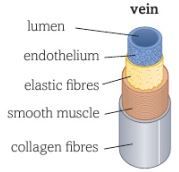![]()
![]()
![]()
Use LEFT and RIGHT arrow keys to navigate between flashcards;
Use UP and DOWN arrow keys to flip the card;
H to show hint;
A reads text to speech;
24 Cards in this Set
- Front
- Back
|
What are arteries? |
Vessels that carry blood away from the heart. |
|
|
What are arterioles? |
Small blood vessels that distributes blood from an artery to the capillaries. |
|
|
What are capillaries? |
Very small vessels with very thin walls. |
|
|
What is a closed circulatory system? |
One in which the blood is held in vessels. |
|
|
What is a open circulatory system? |
One in which the blood is not held in vessels. |
|
|
What are veins? |
Vessels that carry blood back to the heart. |
|
|
What are the venules? |
Small blood vessels that collect blood from capillaries and lead into the veins. |
|
|
What do all blood vessels have to reduce friction with the flowing blood? |
They have an inner layer or lining made of a single layer of cells called the endothelium which is a thin layer that is particularly smooth. |
|
|
Name four characteristics of the artery? |
1) High pressure 2) Thick wall 3) Small lumen 4) The inner wall is folded to allow the lumen to expand |
|
|
Name all the layers of the artery. |

|
|
|
Name five characteristics of the arterioles |
1) Small blood vessels 2) Contains length of Smooth muscle 3) Contraction constrict diameter of the arterial 4) This increases resistance and reduces rate of flow of blood 5) Contractions divert the flow of blood to areas of more demand |
|
|
Name all the layers of the capillary.
|

|
|
|
Name the four characteristics of capillaries |
1) Very thin walls 2) Lumen is very narrow 3) Walls consist of a single layer of flattened endothelial cells 4) Walls are Leaky |
|
|
Name the three characteristics of venules |
1) From the capillaries blood flows into venules 2) Collects blood from the capillary bed and leads it into the veins 3) Wall consists of thin layers of muscle and elastic tissue outside the endothelium and a thin outer layer of collagen |
|
|
Name six characteristics of the veins |
1) Carries blood back to the heart 2) Low pressure 3) Walls do not need to be thick 4) Lumen relatively large 5) Walls have thinner layers of collagen, smooth muscle and elastic tissue 6) They contain valves |
|
|
Name all the layers of the vein.
|

|
|
|
What is an open circulatory system and how does it differ? |
This means that the blood is not always held within blood vessels, instead the blood fluid circulates through the body cavity so that the tissues and cells are bathed directly in blood. |
|
|
What are the two ways that blood is moved around the body in an open circulatory system? |
1) In some animals movements of the body help to circulate the blood and without movement, transport stops. 2) In other animals there is a muscular pumping organ much like a heart. |
|
|
Locust has a muscular pump, how does it work? |
The muscular pump is a long, muscular tube that lies just under the dorsal (upper) surface of the body. Blood enters the heart through pores called ostia. Muscle movement called peristalsis pushes the blood towards the head. At the end of the tube the blood pours out and circulates around the body. The locust can then circulate the blood when at rest but body movement can still help. |
|
|
What are the disadvantages of an open circulatory system? |
1) Blood pressure is low and blood flow is slow. 2) Circulation of blood may be affected by body movements or lack of body movements. |
|
|
How is a closed circulatory system different from a open circulatory system? |
They are in larger animals and the blood is enclosed in vessels. Tissue fluid is found outside the vessels and this bathes the tissues and cells. |
|
|
What are the advantages of a closed circulatory system? |
1) Higher pressure for that blood flows more quickly 2) More rapid delivery of oxygen and nutrients 3) More rapid removal of carbon dioxide and other wastes 4) Transport is independent of body movement |
|
|
Why do the arteries near the heart need a lot of elastic tissue in their walls?
|
Muscle in the heart creates the pressure in the circulatory system. Pressure is highest near heart; vessels must dilate to accommodate the pulses of high pressure blood.
|
|
|
The tissues in the artery walls help reduce the fluctuations in blood pressure. Describe how this is achieved.
|
Wall of artery stretches (dilates), so that pulse of blood is accommodated; the collagen in the wall prevents over stretching; the elastic tissue recoils to return the wall to original size, helping to maintain pressure as blood flows on.
|

